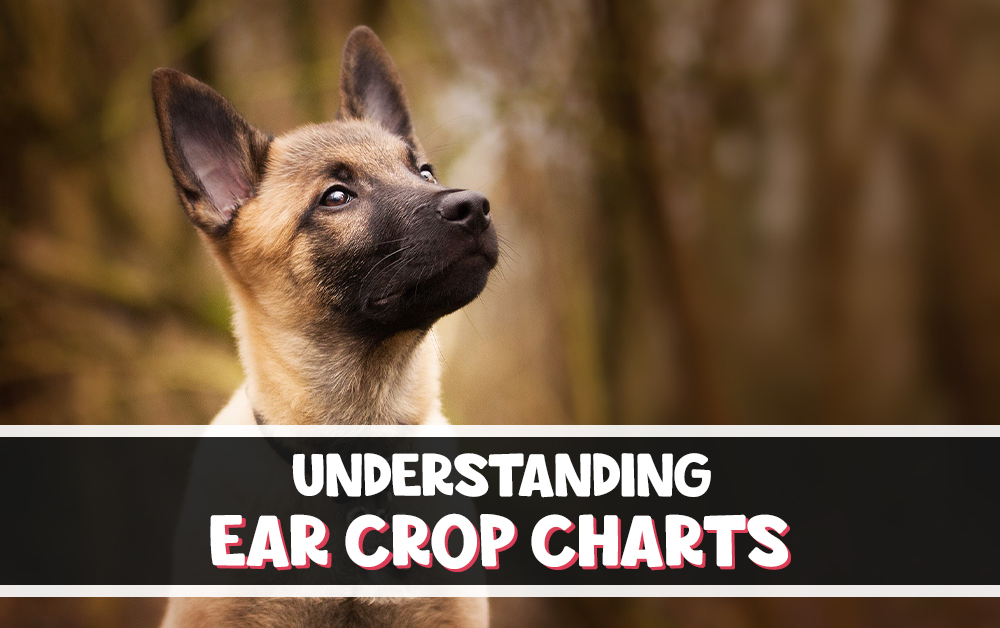While the practice has become controversial due to ethical concerns and animal welfare considerations, it is still performed in some countries and regions. This blog will provide an overview of ear crop charts and tools to guide cropping and achieve a specific look.
We will discuss the purpose of ear crop charts, the different cropping styles, and the factors to consider before deciding on ear cropping for your dog.
What is an Ear Crop Chart?
An ear crop chart is a visual guide veterinarians and breeders use to determine the appropriate shape, size, and angle of cropped ears for specific dog breeds.
The chart typically includes illustrations or photographs of cropping styles, measurements, and guidelines for achieving the desired look.
Ear crop charts are intended to provide a standardized reference to ensure consistency and accuracy in cropping.
Different Cropping Styles and Their Purposes There are several ear-cropping styles, each suited to other breeds and purposes. Some of the most common cropping styles include:
Show Crop
The show crop is a long and narrow cut designed to give the ears an upright and alert appearance. This style is often used for breeds that participate in dog shows, such as Doberman Pinschers and Great Danes.
Short Crop
The short crop is a shorter, more rounded cut that still allows the ears to stand erect. This style is often used for breeds such as the Boxer and Pit Bull Terrier.
Battle Crop
The battle crop is the shortest cropping style, resulting in ears close to the head with a tiny remaining flap. This style was historically used for fighting dogs, as it reduced the risk of injury during a fight. However, dogfighting is illegal in many countries, and the battle crop is generally discouraged.
Factors to Consider
Before Deciding on Ear Cropping Before deciding to crop your dog’s ears, there are several factors to consider:
· Many animal welfare organizations and veterinarians argue that ear cropping is an unnecessary cosmetic procedure that can cause pain and discomfort to the dog. In some countries, the practice is banned or restricted due to concerns about animal welfare.
· Laws regarding ear cropping vary by country and region. Before considering ear cropping, research the legal regulations in your area to ensure you comply.
· Ear cropping is a surgical procedure with risks like infection, bleeding, and anesthetic complications. Additionally, some dogs may experience difficulty with ear positioning or discomfort following the process.
· If you decide to move forward with ear cropping, choosing a veterinarian with experience and expertise is crucial. An inexperienced or unskilled veterinarian may cause unnecessary pain or complications for your dog.
Alternatives to Ear Cropping
If you decide against ear cropping but still want your dog’s ears to have a good appearance, there are alternatives to consider:
· Ear taping is a non-surgical method to encourage a dog’s ears to stand erect. This involves carefully taping the ears upright for a specified period, allowing the cartilage to strengthen and maintain the desired shape.
· Many dog owners opt to leave their dog’s ears in their natural state, embracing the unique appearance of their pets. This approach avoids the ethical concerns and potential health risks of ear cropping.
Factors Influencing the Choice of Ear Crop Style
When considering an ear crop for your dog, several factors come into play when selecting the appropriate style. It’s essential to consider these factors to ensure the best outcome for your pet. Here are the primary considerations:
Breed Standards
Different dog breeds have specific standards set by kennel clubs and breed organizations that outline the desired appearance, including the ear shape. These standards can play a significant role in the choice of ear crop style. Research and understand the breed standards before deciding. Breed standards may vary, and what is desirable for one breed may not be the same for another.
Function or Purpose of the Dog
The dog’s intended purpose can also influence the choice of ear crop style. For example, in some working breeds, such as Boxers or Doberman Pinschers, a shorter ear crop may be preferred to minimize the risk of injury during their active duties. On the other hand, show dogs may require a specific ear crop style to conform to breed standards and enhance their overall appearance in the show ring.
Personal Aesthetic Preferences
Aesthetic preferences play a subjective role in the decision-making process. Some individuals may have a specific style based on their taste or aesthetic appeal. It’s important to remember that personal preferences should not outweigh the consideration of the dog’s well-being and comfort. Prioritizing the dog’s health and happiness should always be the primary focus.
Health Considerations
The health and well-being of the dog should be a significant factor when deciding on an ear crop style. Some dogs may have anatomical factors that make certain styles unsuitable or increase the risk of complications. Consultation with a veterinarian or an experienced veterinary surgeon is crucial to assess the dog’s health and anatomy before making any decisions.
Process of Ear Cropping
Understanding the process of ear cropping is vital before deciding to proceed with the procedure. Here’s an overview of what typically takes place:
A. Age at Which It’s Typically Performed: Ear cropping is usually performed when the puppy is between 8 to 16 weeks old. The timing may vary depending on the breed and the veterinarian’s recommendation. Performing the procedure at a young age allows for better shaping and healing of the ears, as puppy ears are more malleable during this stage.
B. Description of the Surgical Procedure: The procedure involves removing a portion of the ear flap and reshaping it to achieve the desired appearance. The specific technique may vary based on the veterinarian’s expertise and ear crop style. After the surgery, the ears are typically bandaged to facilitate proper healing and shaping.
C. Post-Surgery Care and Potential Complications: Diligent aftercare is crucial after surgery. This may involve regularly cleaning the ears, changing bandages, administering prescribed medications, and monitoring for signs of infection or complications. Potential risks and complications of ear cropping include pain, infection, delayed healing, asymmetry, and ear position or shape changes.
The Ear Cropping Procedure and Post-Operative Care
Understanding the ear cropping procedure and the necessary post-operative care can help you make an informed decision about whether or not to crop your dog’s ears.
· The Procedure: Ear cropping is typically performed on puppies between 8 to 12 weeks of age when the cartilage is still pliable. The procedure is carried out under general anesthesia to minimize pain and discomfort. The veterinarian will use the ear crop chart as a reference to create the desired shape and size, removing the excess ear tissue with surgical scissors or a scalpel. The edges of the ears are then sutured, and a protective bandage is applied.
· Post-Operative Care: Proper post-operative care is essential to ensure your dog heals well and avoids complications:
a. Follow your veterinarian’s instructions for pain management and any prescribed medications.
b. Keep the surgical site clean and dry, and monitor for signs of infection, such as swelling, redness, or discharge.
c. Avoid allowing your dog to scratch or shake their head excessively, as this can disrupt the healing process.
d. Attend scheduled follow-up appointments with your veterinarian to monitor your dog’s progress and remove sutures when necessary.
The Impact of Ear Cropping on a Dog’s Communication and Behavior
Another factor to consider when deciding on ear cropping is the potential impact on your dog’s communication and behavior. Ears play a crucial role in canine communication, and altering their natural shape can have consequences:
a. Canine Communication: Dogs use their ears to convey emotions and intentions to other dogs and humans. Cropped ears may make it more difficult for other dogs to interpret your dog’s body language accurately, potentially leading to misunderstandings or conflicts.
b. Behavior and Temperament: There is no conclusive evidence that ear cropping directly impacts a dog’s behavior or temperament. However, the potential for miscommunication with other dogs could indirectly affect your dog’s social interactions and confidence.
The Future of Ear Cropping and Changing Attitudes
As societal attitudes towards animal welfare evolve, the future of ear cropping remains uncertain.
· Many countries and regions are implementing legal restrictions or outright bans on ear cropping for cosmetic purposes. This trend may continue as more people prioritize animal welfare over aesthetics.
· Some breed organizations and dog show associations are reconsidering their breed standards to accept dogs with natural ears, reflecting the growing opposition to ear cropping.
· The public’s perception of ear cropping is also shifting, with more people viewing the practice as unnecessary and inhumane. This change in opinion may contribute to a decline in the prevalence of ear cropping in the future.
Ending Note
Ear crop charts are a tool veterinarians and breeders use to guide the ear cropping process and achieve a specific appearance for certain dog breeds.
However, ear cropping is controversial and raises ethical, legal, and health concerns. Considering these factors and the potential impact on your dog’s communication and behavior is essential before deciding to crop your dog’s ears.
As societal attitudes towards animal welfare evolve, the future of ear cropping remains uncertain, with more countries implementing legal restrictions or bans and breed organizations reconsidering their standards. When deciding on ear cropping, the primary focus should always be the well-being and happiness of your canine companion.

